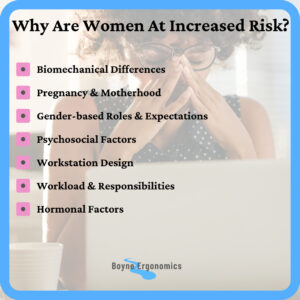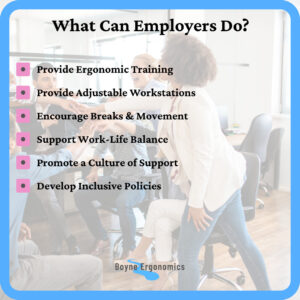Are you aware that women in the workplace often face unique challenges when it comes to their health and well-being? It’s true! According to EU-OSHA (2023), women report less workplace accidents, but report higher levels of work related health issues.
From musculoskeletal issues to stress, there are factors that put women at a higher risk compared to their male counterparts. In recognition of International Women’s Day, I’m here to shed some light on this important topic and offer advice to help employers create a safer and more supportive environment for all employees.
This blog post was prompted, not only by International Women’s Day, but also by a report from August 2023 that has been sitting on my desk for months! It is from the British Occupational Hygiene Society and is titled “Uncovering the UK’s Hidden Crisis in Women’s Workplace Health” and I finally got around to reading recently and felt inspired to look a little deeper.

Why Are Women at an Increased Risk?
Biomechanical Differences:
Women tend to have different body proportions and muscle mass distribution compared to men, including a wider pelvic region, greater Q angle between anterior suprailiac spine and the patella, shorter legs and internal rotation of the femur. Women generally on average have lower muscle mass for body weight compared to men, averaging 28% compared to 35%. This can affect how they interact with their work environment. This can lead to increased strain on certain muscle groups and joints.
Pregnancy and Motherhood:
Balancing work responsibilities during pregnancy and motherhood can put additional stress on women’s bodies. In any workplace, pregnant and postpartum workers are at increased risk of musculoskeletal discomfort due to physical changes associated with pregnancy and postpartum, fatigue and psychological stressors.
Gender-Based Roles and Expectations:
Societal norms and expectations often influence the types of tasks assigned to women in the workplace and the sectors women seek employment. As per EU-OSHA (2014) 60% of women were employed across 6 sectors – healthcare / social services, retail, education, public administration, business activities & hotel / restaurants. Tasks in these sectors often entail repetitive motions, awkward postures, or heavy lifting, all of which increase the risk of injury over time.
Psychosocial Factors:
Women may experience higher levels of stress due to a variety of factors, including workplace discrimination, unequal treatment, or the pressure to balance work and family responsibilities. Chronic stress can exacerbate musculoskeletal issues and lead to other health problems.
Workstation Design:
Many workspaces are still designed with the average male body in mind, which may not adequately accommodate the ergonomic needs of women. Ill-fitting chairs, desks set at incorrect heights and ill fitting PPE can all contribute to discomfort and pain.
Workload and Responsibilities:
Women are more likely to take on multiple roles both at work and at home. According to the Central Statistics Office, in Q3 of 2023, in Ireland, women accounted for 41% of people in full time employment and 69% of people in part-time employment. These figures may be a reflection of the expectation or need for women to take on the caring role in the household. Balancing career demands with household & caring responsibilities can lead to chronic stress, which exacerbates musculoskeletal issues.
Ironically, this post will be published the day after International Women’s Day, because health, work and family demands meant that I could not get this finished on time!
Hormonal Factors:
Hormonal fluctuations during menstrual cycles, pregnancy, and menopause can affect muscle and joint health, making women more vulnerable to pain and discomfort.

How Employers Can Help
The first step is recognising that workplaces do not present the same risks or degree of risk to all employees. By acknowledging that different demographics may be at increased risk of injury, discomfort and stress compared to their counterparts, you can start to develop a workplace that fosters development, inclusion and growth.
Provide Ergonomic Training:
Educate employees, especially managers and supervisors, about the importance of ergonomics and how to identify and address ergonomic risk factors in the workplace. Offer training sessions specifically tailored to the needs of women.
Offer Adjustable Workstations:
Provide ergonomic furniture and equipment that can be adjusted to accommodate different body sizes and preferences. This includes adjustable chairs, desks, and monitor stands to promote neutral postures and reduce strain.
In addition to adjustable workstations, for roles that require PPE, ensure that appropriate fits and sizes are made available.
Encourage Breaks and Movement:
Encourage employees to take regular breaks and incorporate movement into their daily routines. Encourage stretching exercises, short walks, or even standing meetings to reduce the risk of prolonged sitting and alleviate muscle tension.
Support Work-Life Balance:
Recognize the importance of work-life balance and provide resources to help employees manage their responsibilities outside of work. Offer flexible scheduling options, remote work opportunities, and access to childcare support services.
Promote a Culture of Support:
Foster a supportive and inclusive work environment where employees feel comfortable discussing their needs and concerns. Encourage open communication and provide channels for employees to voice their feedback and suggestions for improvement.
Inclusive Policies:
Implement policies that promote diversity, equity, and inclusion in the workplace. Include your female employees in the develop of policies that will impact them. Ensure that women have equal opportunities for advancement and are not disproportionately burdened with caregiving responsibilities.

For International Women’s Day 2024, the theme from the UN is “Invest in women: Accelerate progress.
Investing in women and championing gender equality turbocharges a future where everyone in society can thrive, creating a world of boundless opportunity and empowerment for all.”
By taking proactive measures to address ergonomic concerns and support the well-being of all employees, employers can create a healthier and more productive workplace for everyone. Remember, small changes can make a big difference when it comes to promoting safety and comfort in the workplace. Let’s work together to ensure that women feel valued and supported in their professional endeavors!
Sources
https://www.unwomen.org/en/get-involved/international-womens-day
https://www.internationalwomensday.com/
https://osha.europa.eu/en/themes/women-and-health-work
https://oshwiki.osha.europa.eu/en/themes/women-work-introduction
https://www.mckinsey.com/featured-insights/diversity-and-inclusion/women-in-the-workplace
https://www.cso.ie/en/releasesandpublications/ep/p-lfs/labourforcesurveyquarter22023/employment/


